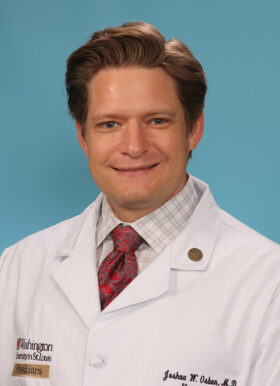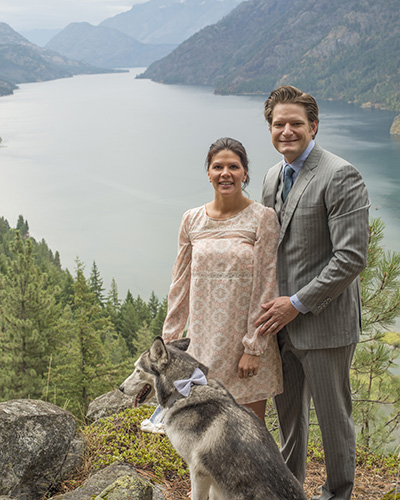Joshua Osbun, MD

Joshua Osbun, MD, is a neurosurgeon who specializes in neurovascular disorders, aneurysms and vascular malformations, carotid disease and cerebrovascular disease.
Dr. Osbun sees patients at:
- The Center for Advanced Medicine, Neuroscience Center, 4921 Parkview Place, St. Louis, MO 63110
Please call 314-362-3577 for an appointment.
What happened in the course of schooling to influence you to choose your specialty?
My mother is a pediatric physical therapist. She has spent her career performing therapy on several children who have long-term neurologic disorders. When I was younger, I enjoyed volunteering at her clinic. I was very interested in her patients’ neurological conditions, what caused the diseases and what procedures were available to help correct the problems.
I got to see how my mother’s patients improved over time with therapy and various neurosurgical procedures. It started me thinking about what I wanted to do. From the time I was 10 years old I wanted to be a neurosurgeon and never really veered from that path.
What brought you to Washington University?
Washington University has a reputation as an incredible place for medicine. They excel all disciplines of medicine – from internal medicine and oncology to neurosurgery, and are a leading edge research institution.
As a medical student, I had a rotation here and was impressed with the institution and the rich history of the neurosurgery department. It was at that time I met Dr. Ralph Dacey, the department chairman. He was a good leader and teacher to the medical students. I admired him and felt he was someone I would love to work for one day.
When I found out Washington University was looking for a neurosurgeon with my specialty, it was a no-brainer to seek out an interview.

Which aspect of your practice is most interesting?
The most interesting aspect about my practice is being able to understand brain blood vessel diseases from both inside the vessel and outside. For instance, I enjoy being able to look at a cerebral aneurysm and determine the best treatment at that time – either a minimally invasive procedure or open surgery.
Having the ability to perform both techniques helps me understand the anatomy and appreciate what issues the patient may encounter with each. What I find most fascinating is being able to think about one problem in many ways — I have many tools at my disposal to be able to treat it.
Most people assume a cerebral aneurysm is quick and most times fatal. Is that true?
A ruptured aneurysm can be very serious. However, in today’s world of advanced imaging, many patients get MRIs of the brain or cat scans for various reasons unrelated to the aneurysm (that they don’t know they have yet). This means we are finding more and more aneurysms that have not ruptured.
When we find an unruptured aneurysm, we explain to the patient what it is, what it means, and what we can expect over the years. We look at a lot of factors – its size, its shape and its location — to determine if it can be watched over time or if it needs treatment sooner rather than later. We weigh all the factors, talk about the best treatment for the patient and come up with a decision together.
A small proportion of aneurysms can rupture, and these can be deadly. That is why we spend so much time on risk stratifying (analyzing and tailoring specific therapies) of unruptured aneurysms.
If an aneurysm does rupture, the outcomes are actually fairly good in a lot of patients. Certainly, some patients are disabled from the rupture or they even succumb to the rupture very quickly. But I would say that greater than 60% of patients who survive the initial rupture can be successfully treated and return to a good quality of life
What new developments in your field are you most excited about?
In the last five years, there have been two exciting developments in my field.
The first is flow diverting stents for large and previous untreatable aneurysms.
These stents have been revolutionary in treating giant aneurysms, and the outcomes are excellent. The previous treatment for a large aneurysm was a very complex and lengthy surgery with a high complication rate.
We are now able to put a very eloquent device into the parent vessel of the aneurysm in order to divert blood away from the weakened area. The results have been fantastic in the treatment of giant aneurysms that we previously treated surgically.
The second is the development of devices that can retrieve blood clots in the brain that are causing a stroke. If someone suffering from an acute stroke receives medical attention within six to eight hours of the onset of his or her symptoms, we can retrieve the clot, re-perfuse the blood vessels and reverse the effects of a stroke in a matter of seconds.
These interventions allow our patients to return to normal function following a stroke that just a few years ago would have had a debilitating effect on their quality of life.
What are the typical stroke symptoms?
FAST is the easiest way to remember the sudden signs of an acute stroke:
Facial droop or numbness on one side
Arm weakness
Slurred speech or the inability to speak and get out your words
Time to call 911
These are all symptoms that go along with a large vessel occlusion (blockage) in the brain. Most patients know that when one or more of these symptoms comes on suddenly, something is really wrong.
I would certainly want to educate the public if they have the symptoms of a stroke to seek medical attention and call 911 as soon as possible. We have very effective treatments now and we no longer have to accept the natural course of the disease.
Are there two different types of stroke?
About 10% of strokes are hemorrhagic strokes. These are a result of bleeding or a burst blood vessel in the brain.
The majority, or 90%, of strokes are ischemic strokes. This is when a blood vessel that has an embolus (a foreign body such as blood clots or air bubbles) travels from another part of the body into the brain and causes a spontaneous blockage of a brain blood vessel.
Hemorrhagic strokes are when the brain actually bleeds, and ischemic strokes where you are no longer getting blood flow to the brain. The new treatments I described are for ischemic strokes.
Where are you from?
I’m originally from northwest Arkansas. I went to medical school in Texas and trained as a neurosurgeon in Seattle, Washington at the University of Washington. My two years of fellowship training were at Emory University in Atlanta — and now I have arrived here at Washington University.
Is there a particular award or achievement that is most gratifying?
Out of all my achievements, the one that meant the most to me was when I was given the Courage to Lead award as chief resident. The award was voted on by the residents at the University of Washington and given to the person who most exemplified the characteristics of a compassionate physician and leader in medicine. It meant so much to me that the people who I worked most closely and spent the most time with wanted to honor me in that way.
What is the best advice you’ve received?
The best advice I’ve received was from my wife. She taught me a lot about balancing my very involved and intense career with outside interests. She reminds me to take time to enjoy life outside of work when I can. Appreciate the present, but realize you have to plan for what is coming next – but at the same time don’t be so focused on the next step that you don’t enjoy life’s moments as they are happening.
If you weren’t a doctor, what would you like to be doing?
I’ve always enjoyed English literature and philosophy. I considered being a liberal arts professor if I hadn’t gone into medicine.
Being a mountain guide is another career I would have enjoyed. I love doing any outdoor activity – such as mountaineering and skiing.
These are two outside interests that would have been reasonable career choices for me.